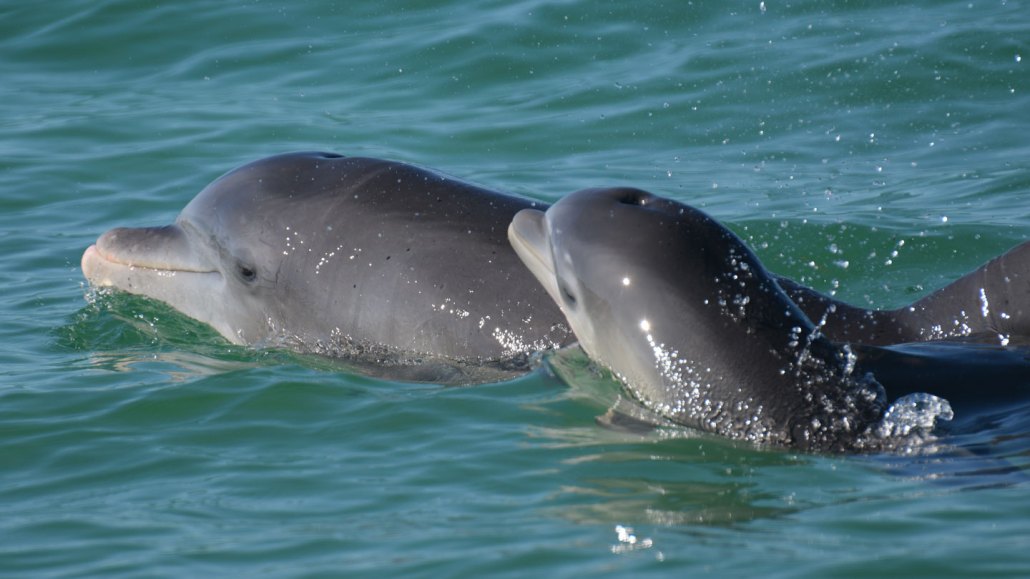Bottlenose dolphin moms baby talk when their calves are near
Mothers use higher-pitched whistles around their babies

Bottlenose dolphin moms make their distinctive whistles more high-pitched when their calves are near, a new study suggests.
Sarasota Dolphin Research Program. Photo taken under NMFS MMPA Permit No. 20455
Share this:
- Share via email (Opens in new window) Email
- Click to share on Facebook (Opens in new window) Facebook
- Click to share on X (Opens in new window) X
- Click to share on Pinterest (Opens in new window) Pinterest
- Click to share on Reddit (Opens in new window) Reddit
- Share to Google Classroom (Opens in new window) Google Classroom
- Click to print (Opens in new window) Print
When speaking to young kids, people often use squeaky, high-pitched baby talk. Some dolphins do, too, it turns out.
When their babies are nearby, bottlenose dolphin moms pitch their whistles differently. This “parentese” could serve a similar role as it seems to in humans. It might boost the calves’ attention, researchers suggest. This might aid bonding and vocal learning.
Researchers shared their findings June 26 in the Proceedings of the National Academy of Sciences.
During the first few months of life, each common bottlenose dolphin (Tursiops truncatus) develops a unique tune. This signature whistle is like a name. The dolphins shout out their own “names” in the water. The calls likely serve as “a way to keep track of each other,” says marine biologist Laela Sayigh. She works at the Woods Hole Oceanographic Institution in Massachusetts.
But dolphin moms seem to tweak their tunes when they’re with their calves. Young dolphins tend to stick by mom’s side for three to six years. Sayigh first noticed a change in the moms’ whistles in 2009. It was part of a study done by her student. Back then, they didn’t get a chance to dig into it.
Now, Sayigh and her colleagues followed up on that observation.
They analyzed signature whistles from 19 female dolphins — both with and without their babies close by. This wild population lives near Sarasota Bay, Fla. Scientists have been studying this community of dolphins for more than 50 years. The audio was recorded during catch-and-release health checks done from 1984 to 2018.
The researchers examined 40 instances of each dolphin’s signature whistle. Half of each mother’s whistles were voiced in the presence of her baby. Whistles when youngsters were around used a wider range of pitches. On average, the highest pitch was a bit higher than when calves weren’t near. The lowest pitch was slightly lower.
Those changes echo human baby talk, Sayigh says.
Dolphin ‘parentese’
When their babies are around, bottlenose dolphin moms modify their signature whistles. They use higher pitches and a wider pitch range than normal. The first audio clip presents a mother’s typical whistle. The second is of her whistle with her calf nearby. To make the high frequency vocalizations audible to human ears, both clips were slowed to one-eighth normal speed.
Bottlenose dolphin signature whistle without calf
Bottlenose dolphin signature whistle with calf
Human caregivers speak to babies with real words but use distinct inflections. Typically, baby talk uses higher pitches and a wider pitch range, like what was observed in the dolphins.
“Bottlenose dolphins are a prime candidate” for kid-focused chatter, says Quincy Gibson. She did not take part in this study, but she does study the behavior of marine mammals. She directs dolphin research at the University of North Florida in Jacksonville.
Much like people, Gibson says, these dolphins form strong mother-baby bonds and learn to vocalize. But she points out that the studied sounds were made during catch-and-release situations. To better understand how dolphins communicate, scientists should listen to freely swimming dolphin moms too, she says. “We do need to look at this question in more natural and undisturbed conditions.”
Plus, notes Mauricio Cantor, it’s one thing to guess that parentese could have the same roles in dolphins as people. But no one can be certain, he says — at least “until the day we can ask the dolphins what they’re actually doing.” Cantor, who studies animal behavior, did not take part in this study. He works at Oregon State University’s Marine Mammal Institute in Newport.
Still, Sayigh says, it “is just really cool” that different species might talk to their babies like we do.







